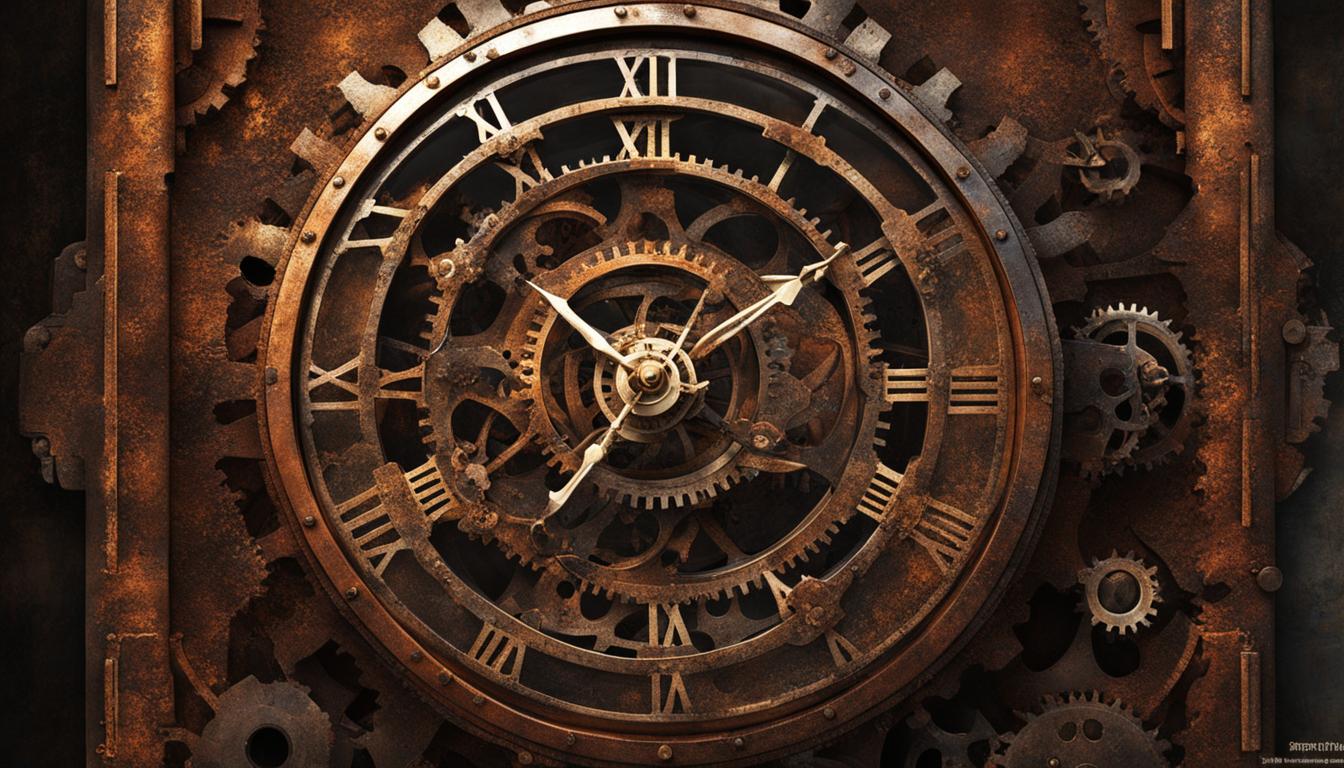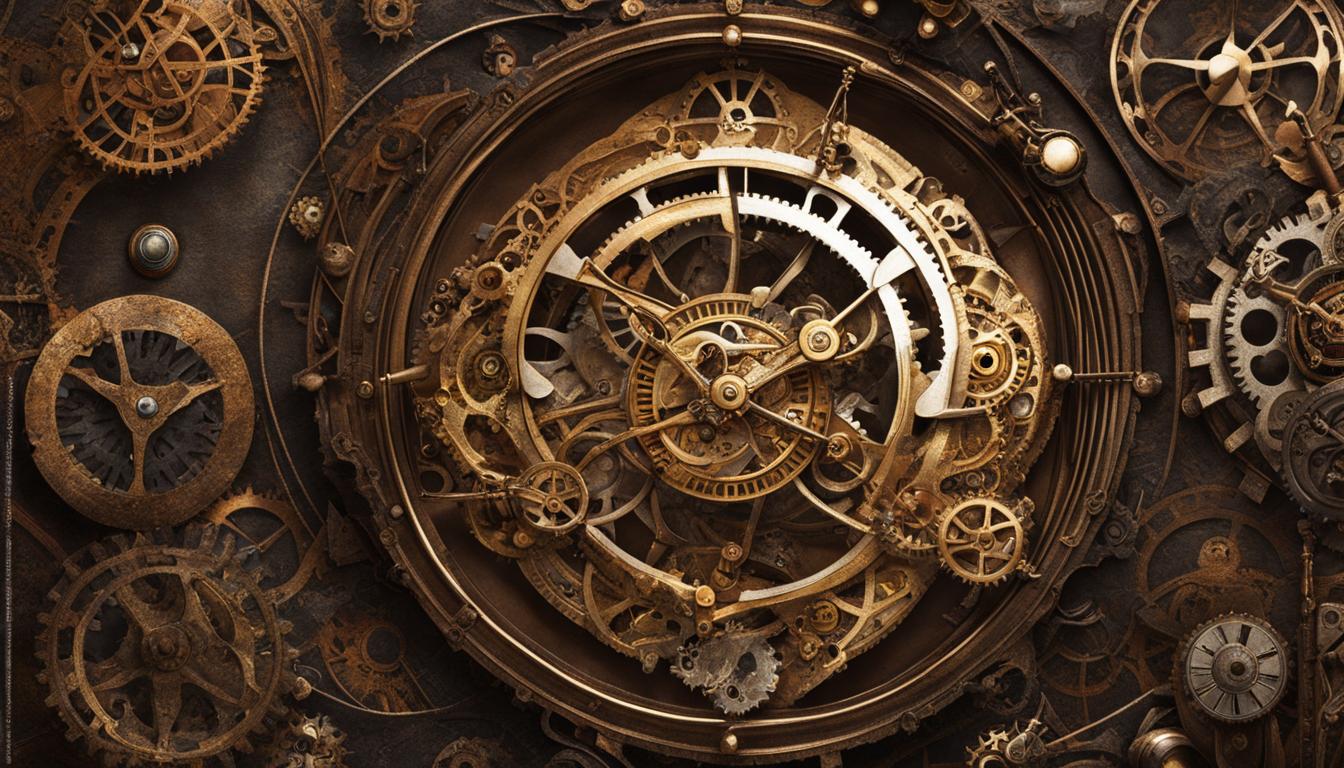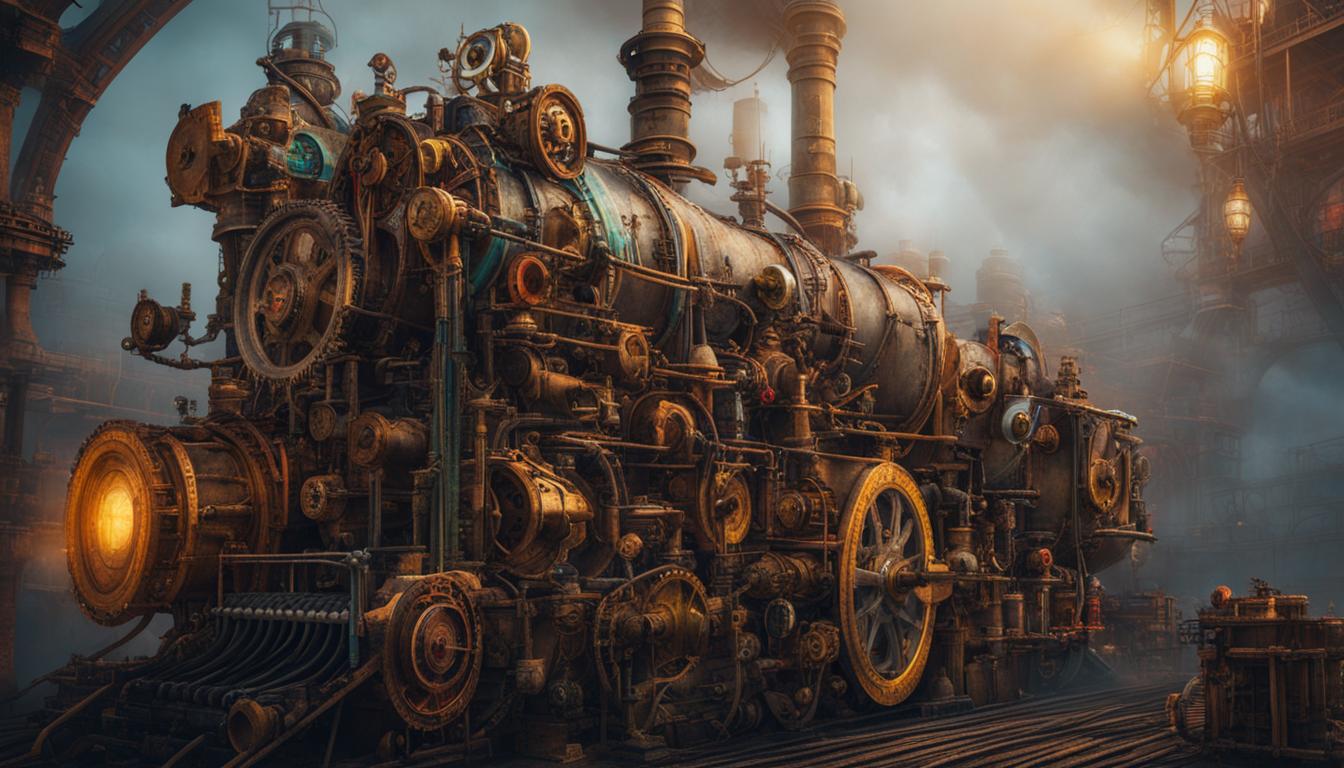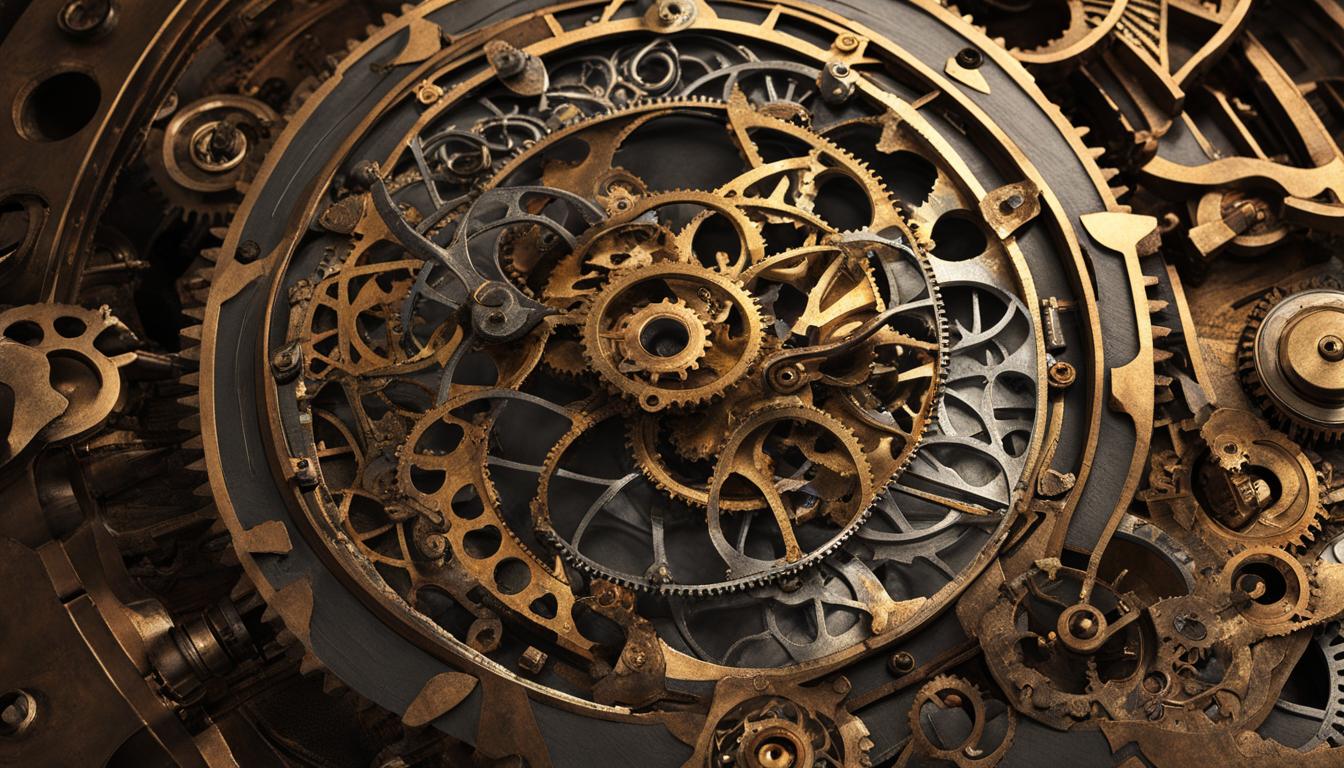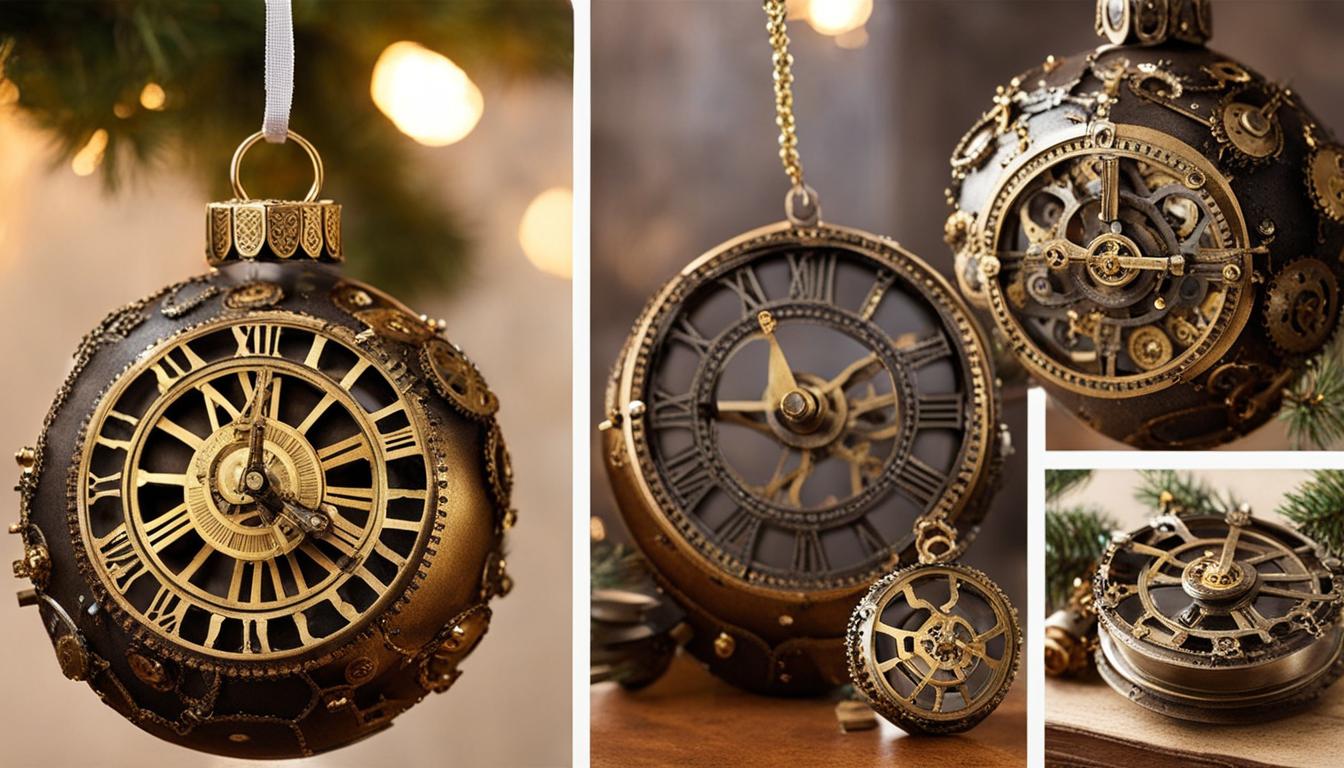Steampunk crafts offer a world of creativity and imagination, where the aesthetics of the Victorian era collide with the technological advancements of the Industrial Revolution. To truly capture the essence of steampunk, mastering the art of aging and distressing techniques is crucial. These techniques not only breathe life into your crafts but also add an air of mystery and intrigue.
Key Takeaways:
- Explore DIY aging methods to achieve a distressed steampunk look.
- Use distressing techniques to add depth and character to your crafts.
- Choose the right colors to evoke nostalgia and emphasize the industrial aspects of steampunk.
- Highlight details with metallic accents for a touch of realism.
- Experiment with sculpting techniques to create unique steampunk figures and characters.
The Victorian Influence on Steampunk Crafts
Steampunk crafts draw heavily from the Victorian era, incorporating ornate details, intricate patterns, and elegant motifs that epitomize the aesthetics of the time. The Victorian influence is evident in the use of vintage fashion, architecture, and machinery, guiding artists to reimagine and repurpose these elements in their creations.
One of the key aspects of the Victorian influence on steampunk crafts is the attention to ornate details. From delicate filigree to elaborate scrollwork, these intricate patterns add a touch of nostalgia and whimsy to steampunk creations. The Victorian era was known for its elaborate embellishments, and incorporating these elements into steampunk crafts helps to create a nostalgic and whimsical feel.
Another important aspect of the Victorian influence is the use of elegant motifs. From botanical illustrations to cameo portraits, these motifs evoke the elegance and refinement of the Victorian era. By incorporating these motifs into steampunk crafts, artists can infuse their creations with a sense of sophistication and charm.
Furthermore, the Victorian influence extends to vintage fashion, architecture, and machinery. Utilizing elements from Victorian fashion, such as corsets, top hats, and bustle skirts, adds an authentic touch to steampunk costumes and accessories. Drawing inspiration from Victorian architecture, with its grandeur and intricate designs, can inform the structure and aesthetics of steampunk crafts. Additionally, incorporating machinery and technology from the Victorian era, such as gears, cogs, and clockwork mechanisms, further enhances the steampunk aesthetic.
The Victorian influence on steampunk crafts is evident in the ornate details, intricate patterns, and elegant motifs that adorn these creations. By embracing the aesthetics of the Victorian era and reimagining them in the context of steampunk, artists can bring a nostalgic and whimsical touch to their craft.
The Industrial Influence on Steampunk Crafts
The Industrial Revolution brought about a wave of innovation and technological advancements that have greatly influenced the steampunk genre. Steampunk crafts, with their distinct blend of vintage aesthetics and futuristic technology, owe much of their appeal to the industrial influence of the era. From the intricate gears and cogs to the mechanical components, these crafts capture the essence of the Industrial Revolution in a visually captivating way.
Steampunk crafts often feature gears and cogs as prominent elements, symbolizing the machinery and mechanical breakthroughs of the Industrial era. These mechanical components are not only decorative but also functional, as they can be incorporated into various art forms, including jewelry, sculpture, and home decor. The use of gears and cogs adds depth and texture to steampunk crafts, giving them an authentic industrial look.
Another aspect of the industrial influence on steampunk crafts is the incorporation of vintage aesthetics. Taking inspiration from the Victorian era and the Industrial Revolution, steampunk artists infuse their creations with the charm and elegance of vintage machinery. The juxtaposition of antique elements against futuristic technology creates a unique visual appeal that defines the steampunk aesthetic.
“The industrial influence on steampunk crafts allows artists to explore the possibilities of repurposing and reimagining machinery from the past, giving it new life and meaning,” says renowned steampunk artist, Jane Smith. “It’s the perfect marriage of nostalgia and innovation, capturing the essence of both the Victorian era and the Industrial Revolution in a single craft.”
Overall, the industrial influence on steampunk crafts is undeniable. From the intricate gears and cogs to the vintage aesthetics, these crafts pay homage to the technological advancements of the Industrial era. By incorporating mechanical components and embracing the charm of vintage machinery, steampunk artists create visually captivating pieces that transport us to a world where steam-powered wonders come to life.
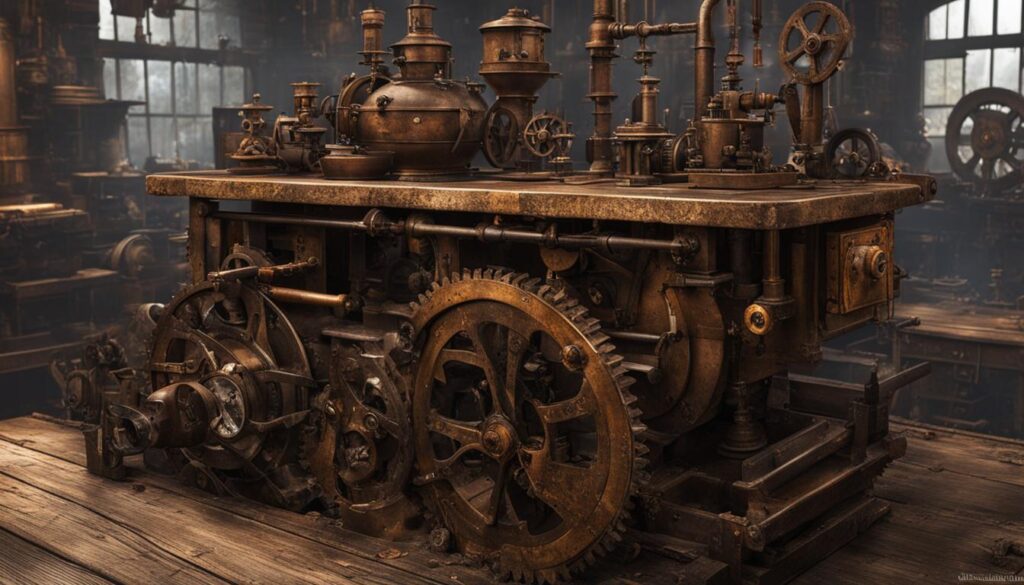
Table: Elements of Industrial Influence in Steampunk Crafts
| Element | Description |
|---|---|
| Gears and Cogs | Symbolize machinery and mechanical breakthroughs of the Industrial era. Add depth and texture to steampunk crafts. |
| Vintage Aesthetics | Incorporate the charm and elegance of vintage machinery. Juxtapose antique elements against futuristic technology. |
| Mechanical Components | Functional and decorative elements that add authenticity to steampunk crafts. Can be incorporated into various art forms. |
Painting Techniques for Aging Steampunk Crafts
Choosing the right colors is a crucial step in achieving the desired aged look in steampunk crafts. Earth tones, metallic shades, and deep browns are commonly used to evoke a sense of nostalgia and portray the industrial and mechanical aspects of steampunk. These colors provide a foundation for the weathered and worn appearance that is characteristic of steampunk crafts.
Distressing and aging techniques are essential for adding authenticity to steampunk crafts. Dry brushing is a popular technique that involves applying a small amount of paint to a brush and then removing most of it by brushing it on a piece of paper or cloth. This technique allows for controlled application, creating a worn and faded effect.
Creating texture and depth is another important aspect of aging steampunk crafts. Using texture paste, embossing powders, and metallic paints can help achieve a three-dimensional and tactile look. These techniques add depth to the surface of the craft and enhance its overall aesthetic.
Highlighting details with metallic accents is a fantastic way to bring out the intricate elements in steampunk crafts. Metallic paints, gilding waxes, and metallic pigments can be used to emphasize gears, cogs, and other mechanical components, giving them a realistic metallic finish. This attention to detail adds visual interest and enhances the overall vintage appeal of the steampunk craft.
The combination of choosing the right colors, utilizing distressing and aging techniques, creating texture and depth, and highlighting details with metallic accents is the key to achieving stunning aged steampunk crafts. These painting techniques allow artists to bring their creations to life and infuse them with the nostalgic and whimsical atmosphere that defines the steampunk genre.
| Painting Techniques for Aging Steampunk Crafts | Aging Steampunk Crafts | Highlighting Details with Metallic Accents |
|---|---|---|
| Choosing the right colors | Distressing and aging techniques | Metallic paints |
| Using earth tones, metallic shades, and deep browns | Dry brushing, sanding, and aging mediums | Gilding waxes and metallic pigments |
| Creating an aged and weathered look | Adding authenticity and character | Highlighting mechanical components |
| Evoking a sense of nostalgia and industrial aesthetics | Enhancing the vintage appeal | Adding visual interest and realism |
The table above summarizes the key points of the painting techniques for aging steampunk crafts. It highlights the importance of choosing the right colors, utilizing distressing and aging techniques, and highlighting details with metallic accents. These techniques work together to create a visually appealing and authentic aged look in steampunk crafts.
Sculpting Techniques for Aging Steampunk Crafts
When it comes to creating aged steampunk crafts, sculpting plays a crucial role in bringing these fantastical pieces to life. By choosing the right sculpting medium and mastering the art of molding and shaping mechanical elements, artists can achieve the distinct steampunk aesthetic. Whether you’re new to sculpting or an experienced artist looking to refine your techniques, this section will guide you through the process of aging steampunk crafts.
Choosing the Right Sculpting Medium
The first step in sculpting aged steampunk crafts is selecting the appropriate sculpting medium. Popular options include polymer clay, epoxy putty, and air-dry clay, each offering its own unique properties and advantages. Polymer clay is a versatile choice that can be baked to harden, allowing for intricate detailing and precise sculpting. Epoxy putty, on the other hand, offers durability and flexibility, making it ideal for creating mechanical elements like gears and cogs. Air-dry clay is a user-friendly option that doesn’t require baking, perfect for beginners or those who prefer a more organic, handcrafted feel.
Molding and Shaping Mechanical Elements
To achieve an authentic steampunk look, mastering the molding and shaping of mechanical elements is essential. A variety of sculpting tools and molds are available to help create texture and shapes that bring out the intricacies of the mechanical theme. From gear-shaped cookie cutters to custom-made silicone molds, these tools enable artists to add depth and dimension to their creations. Don’t be afraid to experiment with different techniques to achieve the desired effect, whether it’s hand sculpting intricate details or using molds for consistency.
Creating Steampunk Figures and Characters
Steampunk crafts often feature figures and characters, adding a sense of storytelling and whimsy to the overall design. When creating steampunk figures, attention to detail is key. Incorporate mechanical elements into the design, such as gears for joints or cog-shaped accessories. Consider the personality and backstory of each character to truly capture the essence of steampunk. Whether you’re sculpting humans, animals, or fantastical creatures, let your imagination run wild and infuse each creation with the spirit of steampunk.
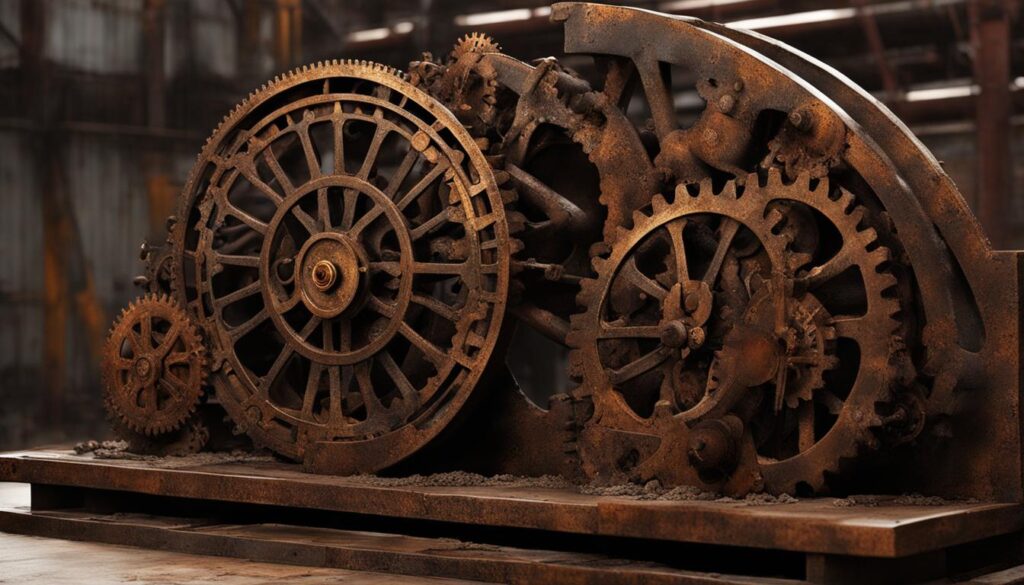
| Sculpting Techniques | Description |
|---|---|
| Hand sculpting | Using your fingers and sculpting tools to shape and mold the clay, allowing for precise detailing and customization. |
| Molding and casting | Creating a master sculpt and then making a mold to reproduce multiple copies of the same design, ensuring consistency. |
| Layering and texturing | Building up layers of clay to create depth and texture, using tools like carving knives or texture stamps to add intricate details. |
| Mechanical embellishments | Adding gears, cogs, and other mechanical elements to enhance the steampunk aesthetic and bring the sculpture to life. |
With these sculpting techniques in your arsenal, you’ll be able to age your steampunk crafts to perfection. Remember to choose the right sculpting medium, master the art of molding and shaping mechanical elements, and infuse each creation with your own unique storytelling. Let your imagination soar as you embark on a steampunk sculpting adventure like no other.
Conclusion
Aging and distressing techniques are the catalysts for turning ordinary steampunk crafts into extraordinary pieces that exude a vintage look. By incorporating these techniques, artists tap into their artistic creativity and imagination, bringing their unique steampunk creations to life.
Journeying into the world of steampunk crafts requires an understanding of the key elements that make up this intriguing genre. The Victorian and industrial influences infuse steampunk crafts with ornate details, intricate patterns, and a mix of vintage aesthetics and futuristic technology.
But it is the aging and distressing techniques that truly elevate the authenticity of steampunk crafts. Choosing the right colors, applying distressing and aging techniques, creating texture and depth, and highlighting intricate details with metallic accents all contribute to achieving the desired vintage aesthetic.
So, let your artistic prowess shine through as you embark on a steampunk crafting adventure. Unlock the secrets of aging and distressing techniques to create stunning and imaginative steampunk crafts that transport you to a world filled with wonder and awe.
FAQ
What are some aging techniques for steampunk crafts?
Some popular aging techniques for steampunk crafts include dry brushing, sanding, and using special aging mediums to create a weathered and worn appearance.
How can I create texture and depth in my steampunk crafts?
You can create texture and depth in your steampunk crafts by using techniques like texture paste, embossing powders, and metallic paints.
What colors should I use to achieve an aged steampunk look?
Earth tones, metallic shades, and deep browns are commonly used to evoke a sense of nostalgia and depict the industrial and mechanical aspects of steampunk.
How can I highlight details in my steampunk crafts?
You can highlight details in your steampunk crafts by using metallic accents, such as metallic paints, gilding waxes, and metallic pigments.
What sculpting medium should I choose for my steampunk crafts?
Popular options for sculpting steampunk crafts include polymer clay, epoxy putty, and air-dry clay, each with its own unique properties.
How can I incorporate mechanical elements into my steampunk figures and characters?
You can incorporate mechanical elements into your steampunk figures and characters by using sculpting tools and molds to create texture and shapes that bring out the intricacies of the mechanical theme.

